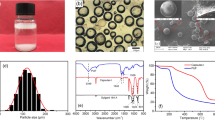Abstract
Urea-formaldehyde (UF) nanocapsules, used as self-healing materials, were prepared by in situ polymerization. Fluorinated silane compound KBM7803 was used to modify the surface of the UF nanocapsules. OM and SEM images exhibited the uniform distribution of nanocapsules without any agglomeration when the amount of KBM7803 was less than 2 %. FT-IR of nanocapsules indicated KBM7803 was easily absorbed on the surface of nanocapsules. The evaluation of thermal stability and mechanical properties revealed that addition of KBM7803 significantly improved the thermal stability, tensile strength, and elastic property. Evaluation of self-healing efficiency indicated when the amount of KBM7803 was 2 %, the material exhibited up to 58.9 and 53.6 % of the first and second self-healing efficiency. XPS indicates that F1s can self migrate to the surface of the cracks which guarantees it can be used as self-healing materials to achieve the repeated self healing property.








Similar content being viewed by others
References
Yin T, Rong MZ, Zhang MQ, Yang GC (2007) Self-healing epoxy composites- preparation and effect of the healant consisting of microencapsulated epoxy and latent curing agent[J]. Compos Sci Technol 67:201–212
Fereidoon A, Ahangari MG, Jahanshahi M (2013) Effect of nanoparticles on the morphology and thermal properties of self-healing poly (urea-formaldehyde) microcapsules[J]. J Polym Res 20(6):1–8
Wu DY, Meure S, Solomon D (2008) Self-healing polymeric materials: a review of recent developments[J]. Prog Polym Sci 33(5):479–522
Wilson GO, Moore JS, White SR et al (2008) Autonomic healing of epoxy vinyl esters via ring opening metathesis polymerization[J]. Adv Funct Mater 18(1):44–52
Blaiszik BJ, Caruso MM, McIlroy DA et al (2009) Microcapsules filled with reactive solutions for self-healing materials[J]. Polymer 50(4):990–997
Yang J, Keller MW, Moore JS et al (2008) Microencapsulation of isocyanates for self-healing polymers[J]. Macromolecules 41(24):9650–9655
Tong XM, Zhang M, Wang MS et al (2013) Effects of surface modification of self-healing poly (melamine-urea-formaldehyde) microcapsules on the properties of unsaturated polyester composites[J]. J Appl Polym Sci 127(5):3954–3961
Jin H, Mangun CL, Stradley DS et al (2012) Self-healing thermoset using encapsulated epoxy-amine healing chemistry[J]. Polymer 53(2):581–587
Li H, Wang RG, Hu HL (2008) Surface modification of self-healing poly (urea-formaldehyde) nanocapsules using silane-coupling agent[J]. Appl Surf Sci 255(5):1894–1900
Wang RG, Hu HL, Liu WB et al (2012) The effect of synthesis condition on physical properties of epoxy-containing microcapsules[J]. J Appl Polym Sci 124(3):1866–1879
van Benthem RATM, Ming W, de With G (2007) Self healing polymer coatings. Self healing materials. An alternative approach to 20 Centuries of Materials Science. Springer, 139–159
Toohey KS, Sottos NR, White SR (2008) Characterization of mcrovascular-based self-healing coatings. Exp Mech. doi:10.1007/s11340-008-9176-7
Acknowledgments
This work was supported by the National Natural Science Foundation of China (21106022), Science and Technology Planning Project of Guangdong Province, China (2013B010404045) and Educational Commission of Guangdong Province, China (Yq2013100).
Author information
Authors and Affiliations
Corresponding author
Rights and permissions
About this article
Cite this article
Cai, X., Fu, D. & Qu, A. Effects of fluorinated silane compound on the repeated self- healing properties of nanocapsules. J Polym Res 23, 18 (2016). https://doi.org/10.1007/s10965-015-0913-1
Received:
Accepted:
Published:
DOI: https://doi.org/10.1007/s10965-015-0913-1




